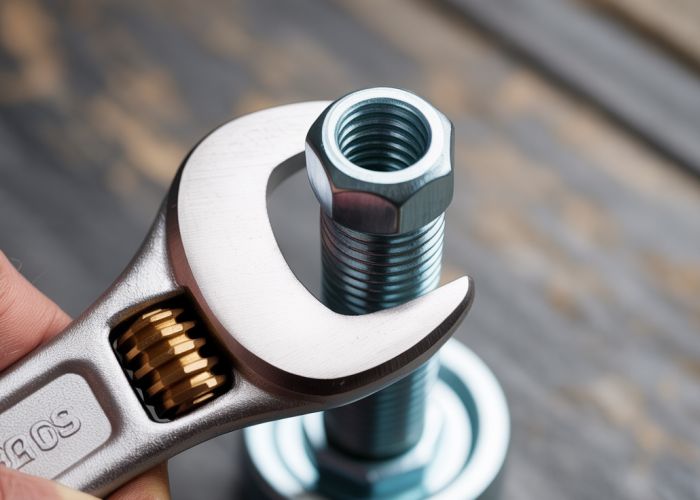The concept of torque and its application within mechanical engineering principles significantly impacts the practical understanding of fastener manipulation. Specifically, the common misconception surrounding clockwise to loosen often leads to complications when working with tools like a wrench or within automotive repair settings. Understanding the threads’ direction on a bolt or nut is critical; the application of force determines whether tightening or loosening occurs, often defying expectations based on simple rotation.

Clockwise to Loosen? Debunking the Myth & Understanding Thread Direction
The phrase "clockwise to loosen" is a common shortcut used when working with threaded fasteners. However, the reality is more nuanced. While generally applicable, it’s crucial to understand when this rule doesn’t apply to avoid damaging equipment or causing injury. This article will explore the factors determining whether clockwise rotation loosens or tightens a fastener.
Understanding Thread Direction: The Key to Loosening
The direction of the threads on a fastener is the most important factor. Thread direction determines whether a clockwise or counter-clockwise rotation loosens the fastener.
Right-Handed Threads (Most Common)
- Most fasteners, like screws, bolts, and nuts, have right-handed threads.
- Right-handed threads tighten when rotated clockwise and loosen when rotated counter-clockwise. This is the assumed standard.
Left-Handed Threads (The Exception)
- Some fasteners utilize left-handed threads. These are less common but crucial to identify.
- Left-handed threads tighten when rotated counter-clockwise and loosen when rotated clockwise. This is the opposite of the right-handed standard and where the confusion often stems from.
Why Use Left-Handed Threads?
Left-handed threads are used in specific applications where the operating conditions might unintentionally loosen a right-handed thread.
- Preventing Self-Loosening: Rotating parts can gradually loosen fasteners due to vibration and friction. Left-handed threads are often used in situations where the rotation tends to tighten them, preventing accidental loosening. Examples include:
- Bicycle pedals (left pedal has a left-handed thread)
- Certain types of lawnmower blades
- Propellers (on some equipment)
Identifying Left-Handed Threads
Identifying left-handed threads is crucial before attempting to loosen a fastener. Incorrectly applying the "clockwise to loosen" rule can damage the fastener or the surrounding material.
Visual Inspection
- Thread Angle: If possible, visually inspect the angle of the threads. It’s often difficult to discern without experience. A right-handed thread slopes downward from right to left. A left-handed thread slopes downward from left to right.
- Markings: Some fasteners are marked to indicate left-handed threads. Look for markings like "LH," "L," or an arrow pointing counter-clockwise. However, markings are not always present.
Trial and Error (With Caution)
- Gentle Attempt: Carefully attempt to turn the fastener both clockwise and counter-clockwise. If one direction provides significant resistance, stop and consider the possibility of left-handed threads. Do not force it.
Consulting Documentation
- Equipment Manuals: The best way to determine thread direction is to consult the equipment’s service manual or parts diagram. These resources typically specify the thread direction of all fasteners.
Real-World Examples: When "Clockwise to Loosen" Fails
Here are some common examples where relying on the "clockwise to loosen" rule would be incorrect:
| Application | Thread Type | Loosening Direction | Tightening Direction |
|---|---|---|---|
| Bicycle Left Pedal | Left-Handed | Clockwise | Counter-Clockwise |
| Some Lawn Mower Blades | Left-Handed | Clockwise | Counter-Clockwise |
| Propellers (certain types) | Left-Handed | Clockwise | Counter-Clockwise |
Best Practices for Removing Fasteners
- Identify the Thread Type: Determine if the fastener has right-handed or left-handed threads before attempting to loosen it.
- Use the Correct Tools: Use the appropriate size and type of wrench or socket to avoid damaging the fastener.
- Apply Penetrating Oil: If the fastener is rusted or corroded, apply penetrating oil and allow it to soak for a sufficient time.
- Apply Steady Pressure: Avoid jerky movements, as this can strip the threads or break the fastener.
- Seek Professional Help: If you are unsure about the thread type or are unable to loosen the fastener, consult a qualified mechanic or technician.
Clockwise to Loosen? FAQs
Here are some common questions about tightening and loosening bolts, and when clockwise directions might actually loosen things.
Why would turning something clockwise loosen it?
The most common reason is a left-handed thread. Standard threads tighten when turned clockwise, but left-handed threads are the opposite. Therefore, to loosen something with a left-handed thread, you would turn it clockwise.
Where are left-handed threads typically found?
Left-handed threads are deliberately used in specific applications where vibration or rotation might unintentionally loosen a standard, right-handed thread. Bicycle pedals on the left side and some gas fittings are common examples.
How can I tell if a bolt or screw has a left-handed thread?
Usually, the bolt or screw will be marked with an "L" or "LH." Without a marking, careful visual inspection may reveal the direction of the thread. Remember that if you need to turn it clockwise to loosen it, it’s likely a left-handed thread.
Is "righty tighty, lefty loosey" always true?
While "righty tighty, lefty loosey" is a helpful general rule, it doesn’t apply to everything. Left-handed threads are the exception. You must consider the threading type to correctly tighten or loosen a fastener. Sometimes, clockwise to loosen is the correct approach.
So, next time you’re wrestling with a stubborn bolt, remember that clockwise to loosen isn’t always the rule! Hopefully, this cleared things up. Happy wrenching!